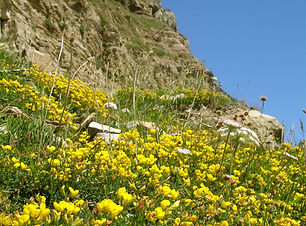
Hastings Country Park Nature Reserve
A 345 hectare costal nature reserve extending from the East Hill to Firehills on the eastern boundary of Hastings Borough, East Sussex, UK. The nature reserve sits within the Hastings Cliffs Special Area of Conservation, the Hastings Cliffs to Pett Beach Site of Special Scientific Interest and the High Weald National Landscape.
One of the most biodiverse habitats in Britain. An invertrbate rich habitat supporting some very rare and endangered species. Specialised coastal plant communities are present and a diverse community of cliff nesting birds.
A greatly declined solitary bee that used to be much more widespread in the High Weald. The cliffs and meadows are a stronghold for the species within the reserve.

Lowland Dry Heath
Lowland dry heath and lowland dry acid grassland are both invertrbrate rich habitats supporting many rare and scarce species. The coastal maritime heath and acid grassland is also a magnet for bird migration in spring and especially autumn.

Phoenicurus ochruros (black redstart) [Photo: Crystal Ray]
This striking insectivorous bird first bred in Britain on the cliffs of Hastings in 1923. A cliff nesting species which has adapted to urban structures & buildings. A thriving population still nests amongst the rocks and boulders on the undercliff with upto five pairs present.

Ancient Gill Woodland
The ancient gill woodland in Hastings has a fragile humid microclimate ideal for mosses and liverworts, some of which are very rare and scarce in south-east England. The gill stream invertebrate communities are rare and fragile.

Dumortiera hirsuta (Dumortier's liverwort)
About 50% of the population of this rare oceanic liverwort in England occurs within the reserve. It is a large thallose liverwort which grows on rock and soil in humid conditions near water, especially waterfalls.
Hastings Country Park Local Nature Reserve is owned and managed by Hastings Borough Council. For more information click here: https://www.hastings.gov.uk/countryside-nature/

